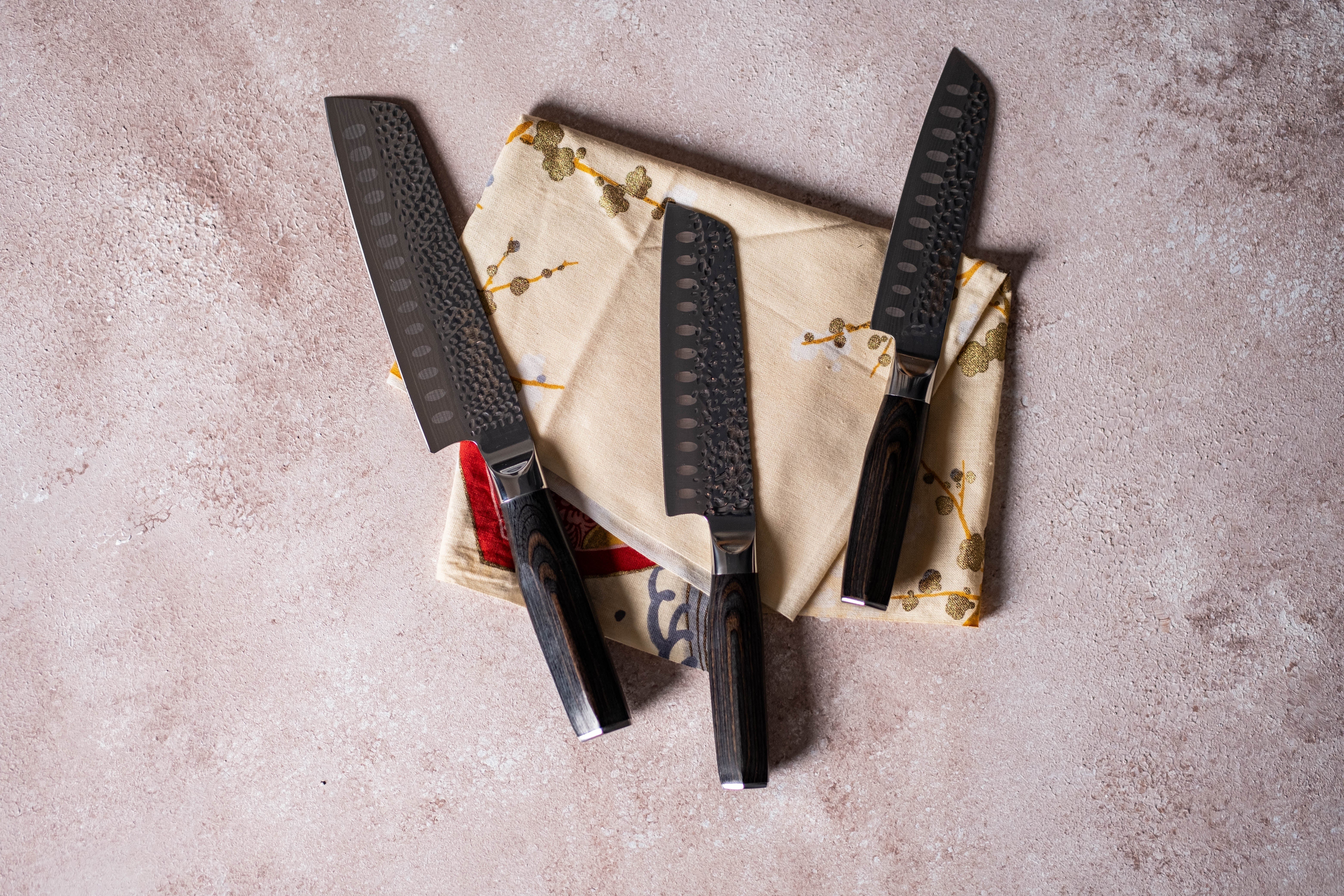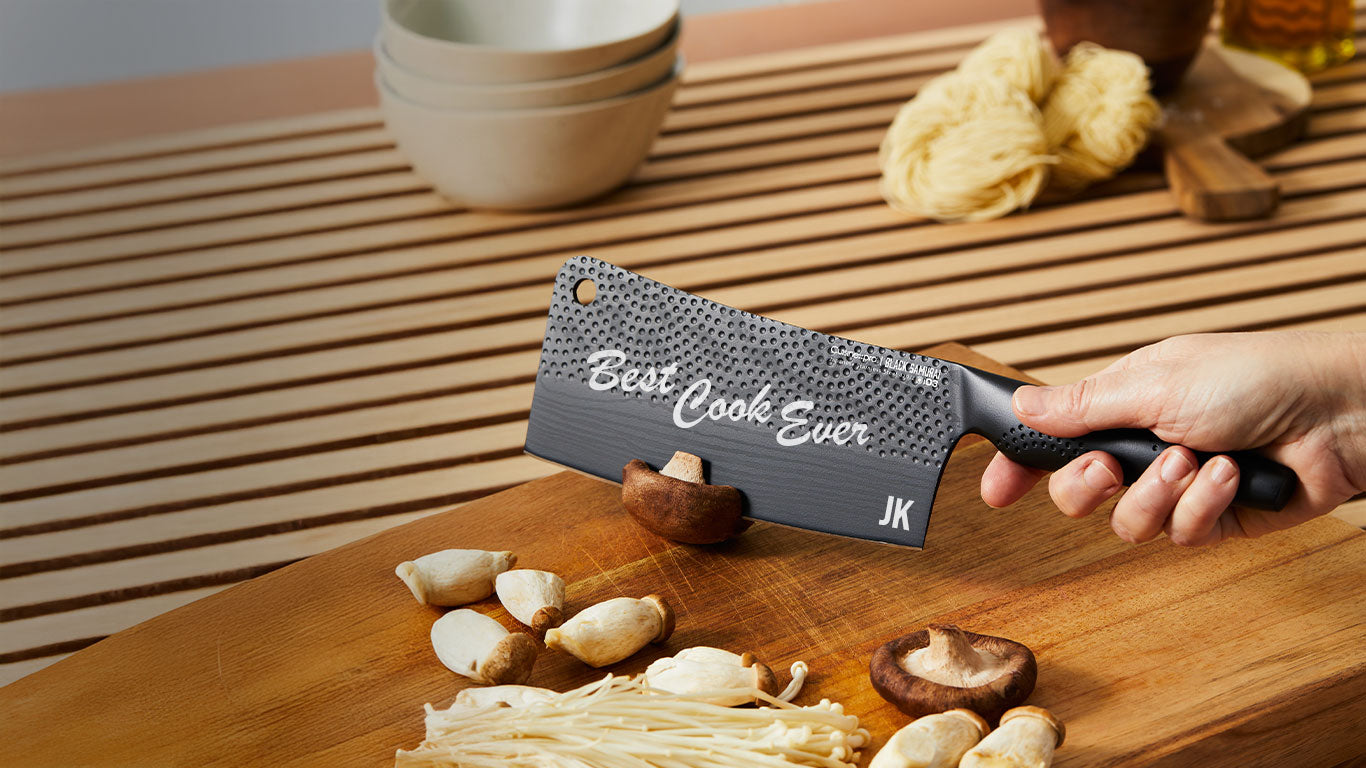The Ultimate Knife Buying Guide: How to Choose the Tools You Need
THE CUSTOM CHEF™ . June 18, 2025

1. How to Choose a Kitchen Knife
What kitchen prep tools are you likely to reach for more than any other? Your knives. They’re crucial to practically every part of meal prep. Slicing veggies for salad? Cubing tofu or steak? Peeling apples for pie? You’ll need a knife for every one. Choosing the right knife for the task will streamline the process, speeding you through your job efficiently, safely, and yielding chef’s kiss-worthy results.
It’s valuable, therefore, to learn the intricacies of different knife types as they each have their own superpowers. Some will tackle that tough squash skin in no time. Others are ready made for more delicate work, like mincing tender herbs. Still others were designed to handle meat or fish. In short, whatever food or preparation technique you use, there’s a knife especially suited to help. Read on to better understand these essential tools so you’ll always choose the right prepping partner. Then head to THE CUSTOM CHEF™ to pick out your perfect lineup.
2. Types of Knives and Their Uses
The type of knife you need depends on the job you’re doing. So, begin by getting familiar with the range of knife options.
Chef’s Knife
With its medium size and skill at slicing, chopping, and dicing both meat and vegetables, a Chef’s knife is one of the most versatile options. When shopping, look for a sharp point at the tip and a wide blade with a sloping edge, which facilitates the signature rocking motion used by chefs for more precise cutting.

Paring Knife
Petite and nimble, paring knives are built for precision tasks like mincing, slicing, and peeling fruits and vegetables.

Santoku Knife
These knives are ideal for thinly slicing and dicing fish, fruit, and vegetables. Shorter than Chef’s knives, Santoku blades have shallow indentations that help foods release from, instead of stick to, the knife.

Boning Knife
This knife’s slim, stiff blade is tops at efficiently separating meat from bones.

Serrated Knife
With its scalloped edge, a serrated knife is great at slicing crusty bread (and other foods with a hard outside and soft inside), meat, and the waxy, slippery skin of tomatoes.
Utility Knife
One of the most frequently used kitchen tools, utility knives are all-purpose favorites for prep, skilled at slicing meat, medium-sized vegetables and fruit, cutting sandwiches or buns, and more.

Filleting Knife
Similar to a boning knife, filleting knives are slim, long, and flexible, designed to skin and slice fish, devein shrimp, and remove delicate bones with ease.

Carving Knife
Want to impress dinner guests with even, elegant slices of roast chicken, turkey, or tenderloin? Bring out the carving knife.

Bread Knife
These long, serrated knives can multitask, slicing through the hard outer shell of baguettes, sourdough, and other breads while protecting the soft interior.

Cleaver
This large knife is a butcher’s best friend. Its wide blade is primed to handle thick cuts of meat when chopping or splitting meat from bone.

Steak Knives
Once that thick steak is cooked to perfection, the serrated edge of a steak knife will handily cut it into bite-sized pieces.

3. Which Knife for Which Foods?
- Meat Use a boning knife for deboning, a cleaver for thick cuts, and a Chef’s or Santoku for slicing or cubing meat.
- Fish Go with a filleting knife for delicate tasks, Santoku for even slices, and paring knife for detail work like deveining shrimp.
- Fruits & Vegetables Use a Chef’s knife for chopping, Santoku for thin slicing, and a paring knife for peeling or trimming.
- Herbs A paring knife offers the precision needed to preserve the texture and flavor of delicate herbs.
4. Guide to the 10 Essential Knife Cuts
- Chop Rough or uniform pieces; best with a Chef’s knife.
- Dice Small, even cubes of herbs or vegetables.
- Mince Very finely chopped—ideal for garlic or shallots.
- Slice Thin, even slices using a Santoku or Chef’s knife.
- Julienne Thin, matchstick-like strips; great for slaws and garnishes.
- Chiffonade Leafy greens rolled and sliced into ribbons.
- Cube Uniform cubes—commonly used in stews or salads.
- Wedge Triangular sections; ideal for cabbage or potatoes.
- Bias Cut Diagonal slices for stir-fry vegetables or meats.
- Rondelle Thin, round slices from cylindrical produce like carrots.
5. Material Matters: Blade and Handle Choices
Blade Types
-
Japanese Steel
Lightweight, thin, easy to sharpen; best for produce and seafood. -
German Steel
Heavier and more durable; good edge retention, better for thick meats. -
Stainless Steel
Affordable, rust-resistant, holds an edge well. -
Carbon Steel
Razor-sharp and easy to hone, but prone to rust without care. -
Ceramic
Very sharp and low-maintenance, but fragile and chip-prone. -
Full Tang vs. Half Tang
Full tang knives are more balanced and durable. Half tangs are lighter but less sturdy.
Handle Types
-
Plastic/Polymer
Lightweight and ergonomic, ideal for detailed work. -
Stainless Steel
Hygienic and rust-proof, often part of a seamless design. -
Pakkawood
Water-resistant and stylish—common in premium Japanese knives. -
Wood
Classic look and feel, but can absorb moisture if not cared for.
6. Conclusion
When building your knife collection, consider your favorite ingredients, your cutting techniques, and how much maintenance you're willing to handle. Whether you’re prepping vegetables, breaking down a roast, or skinning fish, choosing the right knife makes all the difference.
Explore the curated selection of premium kitchen knives at THE CUSTOM CHEF™ and find the tools that fit your cooking style best.
Related Articles
Discover All >



